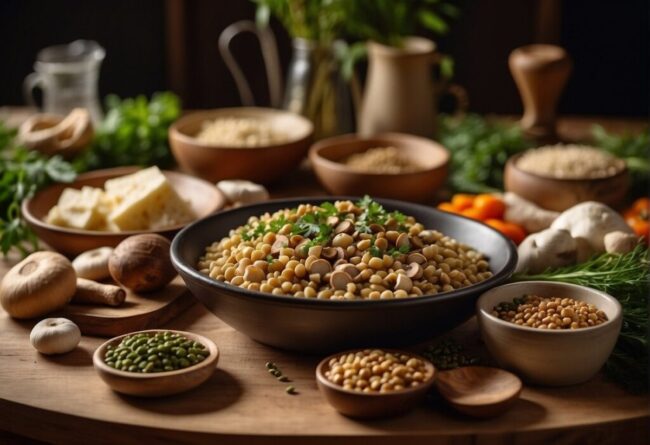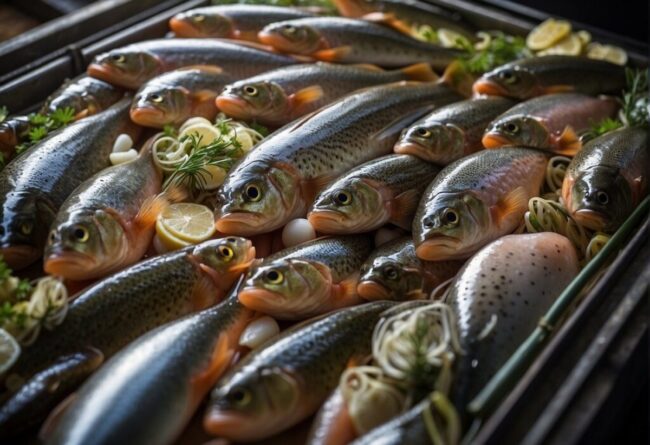Flavorful Substitutes to Use Instead of Trout
Trout substitutes help recreate fresh, flaky seafood dishes even when this fish isn’t available.
Some choices keep the light texture intact, while others add a slightly firmer bite.
Cooking styles like grilling, baking, or smoking can influence the best replacement.
Matching flavors and consistency makes all the difference in achieving a satisfying result.
Enjoying a delicious seafood meal remains just as simple with the right alternative.
What to Know About Trout
Trout is a freshwater fish known for its mild, delicate flavor and flaky texture. It is commonly prepared by grilling, baking, or pan-searing.
Trout Features Explained
Trout thrives in freshwater and cold-water habitats, making it a favorite among anglers and chefs alike.
Rainbow trout shines with its elongated body, featuring a striking pinkish stripe that adds visual appeal to any dish.
Brown trout captivates with its buttery brown hues and unique spotted patterns, showcasing nature's artistry.
These fish prefer pristine environments; clear waters are their natural playgrounds due to their sensitivity to pollution.
The mild flavor of trout lends itself well to various culinary styles, allowing for creativity in preparation and presentation while ensuring an enjoyable dining experience every time you savor it.
Trout Health and Benefits
Trout serves as a powerhouse of nutrients, making it an excellent addition to your diet.
This fish provides omega-3 fatty acids that play a vital role in heart health and eye function.
High-quality protein found in trout supports muscle growth and recovery after exercise.
B-complex vitamins, particularly B12 and niacin, work together with essential minerals like phosphorus and selenium to enhance overall well-being.
Consuming trout can lead to improved red blood cell production while promoting strong bones and healthy nerve function throughout the body.
Factors to Choose Best Trout Substitutes
The best trout substitutes include other mild, flaky fish like tilapia, cod, or Arctic char. Choosing the right alternative ensures similar cooking results.
Choosing Substitute Factors
Fish availability varies based on where you live, with local geography and seasonal changes playing key roles.
Choosing sustainable fish options can help protect marine ecosystems and support responsible fishing practices.
When seeking alternatives, consider those rich in omega-3 fatty acids and vitamin D to maintain health benefits similar to trout.
Pay attention to how well the substitute mimics the tender texture and mild flavor of trout for a satisfying culinary experience.
Budget constraints often influence choices, so exploring affordable substitutes might be worthwhile for your meals without compromising quality or taste.
Texture and Flavor Comparison
Finding the right substitute for trout can enhance your culinary experience.
A firm texture often appeals to those who enjoy salmon or halibut, providing a satisfying bite.
For lighter dishes, delicate options like tilapia and flounder create a softer mouthfeel that complements various sauces beautifully.
Flavor plays a crucial role; if you prefer something mild, Arctic char or bass might suit your palate well, while mackerel and tuna deliver bolder tastes for adventurous eaters.
Consider what matters most to you, whether it's health benefits or cost, as this choice can significantly influence meal preparation and enjoyment.
Best Trout Substitute Options
Salmon, a fish that thrives in both freshwater and saltwater, offers a firm texture alongside flavors that can shift from subtle to bold.
Its adaptability in recipes makes it a favorite among chefs and home cooks alike.
Arctic char is another excellent choice, sharing similarities with trout and salmon but standing out with its tender flesh and gentle taste.
For those looking for something budget-friendly, tilapia shines as an accessible option; its mild flavor pairs well with various seasonings or sauces.
Each of these fish brings unique qualities to the table, catering to diverse culinary needs while satisfying different palates.
Fish Alternatives in Recipes
Using fish alternatives in recipes requires adjusting cooking methods and seasonings. Selecting the right substitute helps maintain balance in flavor and texture.
Oven-Baked Fish Meals
Baked fish dishes offer a delightful way to enjoy a variety of flavors.
Rainbow trout takes center stage, but salmon and arctic char serve as excellent alternatives.
Salmon presents a rich, meaty texture that enhances any recipe calling for bold flavors.
Arctic char provides a milder taste with tenderness that pairs beautifully with various seasonings.
Cod and haddock shine when you crave subtlety, showcasing their flaky qualities while absorbing the essence of the dish beautifully.
Grilled Fish Options
Grilling fish requires selecting varieties that can handle intense heat without falling apart.
Mahi mahi and snapper have a dense texture, making them reliable options for the grill.
Swordfish and bluefish add their own distinctive tastes, thriving on those smoky notes from the flames.
Their hearty nature allows them to hold up beautifully during cooking while enhancing any marinade or seasoning used.
Whether you’re hosting a barbecue or enjoying a quiet dinner at home, these fish promise satisfying meals that celebrate bold flavors and delightful textures.
Storing and Preparing Ingredients
Storing and preparing ingredients properly preserves freshness and enhances flavor. Proper handling techniques ensure food safety and quality.
Correct Storage Methods
Storing your chosen trout substitute properly ensures it remains fresh and flavorful.
Fresh fish thrives in cold temperatures, so refrigerate it right away at 32-36°F.
If you plan to keep it longer, freezing is a smart choice that locks in taste for months.
Clean the fish well before drying and wrapping it securely with plastic or foil, then don’t forget to label with the date for easy tracking.
Canned options like tuna require a cool pantry; after opening, store leftovers in a sealed container and use them within three days for the best quality.
Getting Ready for Freshness
Preparation plays a crucial role in how fish turns out when cooked.
For those richer in fat, like mackerel and tuna, letting them sit at room temperature helps achieve a perfect cook.
Leaner varieties such as tilapia only need a brief rest before they hit the heat.
Rinsing the fish under cold water and drying it thoroughly ensures that any excess moisture won’t interfere with cooking methods.
Marinating can work wonders for flavor; just be cautious with delicate types like flounder to prevent overpowering their subtle taste while considering sustainable choices that support both health and the environment.



